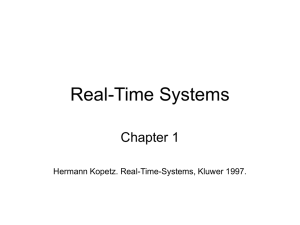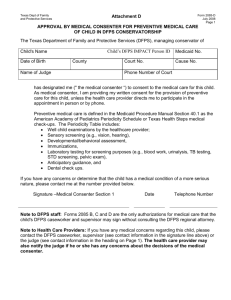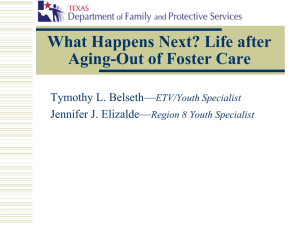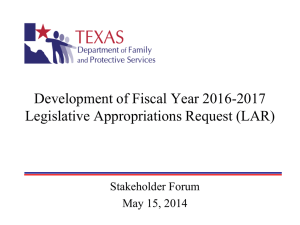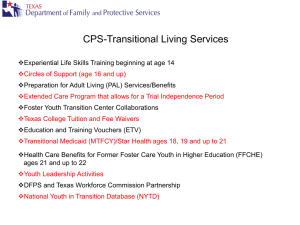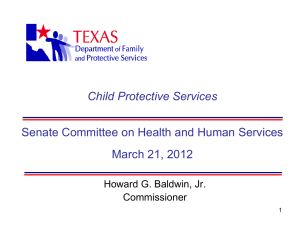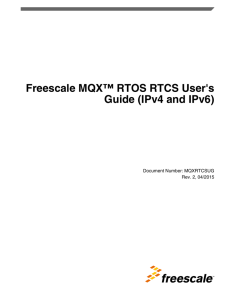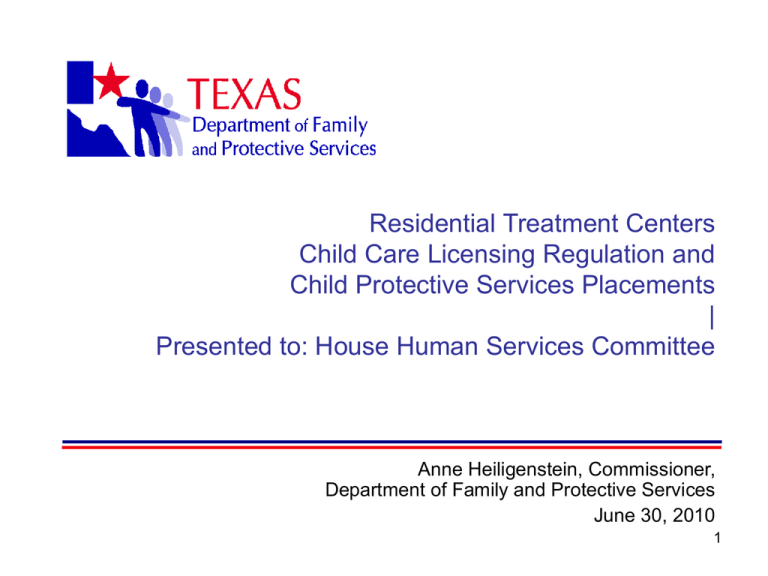
Residential Treatment Centers
Child Care Licensing Regulation and
Child Protective Services Placements
|
Presented to: House Human Services Committee
Anne Heiligenstein, Commissioner,
Department of Family and Protective Services
June 30, 2010
1
Residential Treatment Centers:
Historical Perspective
2
DFPS Reform I
Senate Bill 6, 79th Legislative Session (2005)
• Increased the minimum qualifications for Licensed Child
Care Administrators
• Required residential operators to self-report more
serious incidents
• Increased background check requirements for
residential child care employees
• Required drug testing for residential child care
employees
• Required residential operators to provide emergency
behavior training approved by Residential Child Care
Licensing (RCCL)
3
DFPS Reform II
Senate Bill 758, 80th legislative session (2007)
•
•
•
•
Created the Committee on Licensing Standards
Required RCCL team inspections
Increased number of RCCL staff
Created new rate category for foster children
immediately after discharge from psychiatric hospitals
• 4.3% rate increase for residential care providers
4
Strengthened Residential Treatment Center
Minimum Standards - Effective January 2007
•
•
•
•
Staff to child ratios dropped from 1:8 to 1:5
Raised minimum age of caregiver from 18 to 21
Raised minimum qualifications for Treatment Director
Increased training requirements for both caregivers
and professional staff
5
Residential Treatment Centers:
RCCL oversight
At every RTC, on average, RCCL conducts the following
activities each year:
• 16 inspections
• 12 investigations
6
Capacity Challenges
As recently as 2007, CPS faced significant placement
challenges:
• Number of foster children grew faster than the number of
placements available.
• Increases in both regulation and enforcement at residential
facilities resulted in RTCs being reluctant or unwilling to
admit children with high-risk behaviors. The increased
serious incidents and resulting investigations created
liability concerns for RTCs.
• As a result, children were spending nights in DFPS offices
or other locations.
7
Residential Treatment Centers:
Current Challenges and
Potential Solutions
8
Residential Treatment Centers:
Where are they?
Region
Number of Licensed RTCs
Number of Contracted RTCs
1 - Lubbock
2
2
2 - Abilene
1
1
3 - Arlington
7
6
4 - Tyler
4
4
5 - Beaumont
2
2
6 - Houston
37
33
7 - Austin
13
9
8 - San Antonio
12
8
9 - Midland
0
-
10 – El Paso
1
-
11 - Edinburg
1
1
80
66
TOTAL
9
CPS Use of Residential Treatment Centers
• As of June 1, 2010, DFPS had 1,583 children in RTC
placement.
• This represents 9.5% of children in paid foster care
placement.
• Out of 66 DFPS contracted RTCs, 33 or one-half are
located in the Houston region alone. Many children are
placed into these facilities from other regions.
• Six out of ten children placed in Houston region RTCs are
from other regions across the state.
10
Children in RTCs
Because children in the conservatorship of DFPS are victims
of abuse and/or neglect, the trauma that they have endured
can result in significant treatment needs. These children
experience not only the trauma, but great loss by being
removed from their homes, schools and friends. Also, the
children often have serious underlying medical and
developmental needs.
11
Children in RTCs
17 year old female-removed from the home due to sexual
abuse.
• Reports hearing voices telling her to hurt herself
• History of verbal and physical aggression, including
homicidal threats
• Suffers from depression, suicidal ideation, and selfmutilation
• Diagnosed PTSD and Bipolar with an IQ of 89
• At her last placement, she assaulted an RTC staff with the
leg ripped from an overturned table. The staff lost her eye.
• This youth has had 26 placements since coming into care.
12
Children in RTCs
17 year old Female
• Physically aggressive to both children and adults
• History as a sex offender against a sister in her adoptive
home
• History of suicidal thoughts, running away, property
destruction, and making false accusations
• Bipolar Disorder, ADHD, PTSD, Fetal Alcohol Syndrome,
and Oppositional Defiant Disorder with an IQ of 90
• Referred to juvenile authorities at least 5 times for theft,
sexual assault and assault
• Since 2005 has had over 42 placements including multiple
stays in psychiatric hospitals, RTCs, and emergency
shelters. She considers the hospital to be a "safe place"
and will do whatever is necessary to be hospitalized.
13
Challenges for RTCs
Both RTCs and DFPS face the challenge of balancing:
• Privacy rights of children with supervision and security
needs
• Need for older children to learn independent living skills
while still keeping them safe
• Risk of physically preventing a child from running away or
hurting themselves or others versus the risk a child will face
on the streets or incarcerated
• RTC workforce challenges – turnover, training, ratios
14
New Minimum Standards Rules Changes
Minimum standards revisions to be proposed for adoption in
July:
• New rule clarifying that RTCs must operate at all times as if
100% of their children receive emotional disorder treatment
services, whether or not the children are “eligible” or
“qualify” for those services
• Requiring facilities to document and assess children’s
“high-risk behaviors” at the time of admission for each child
• Clarifying in rule that employees, contractors, volunteers,
etc. are required to report suspected abuse, neglect, or
exploitation directly to DFPS, and may not rely on the
facility’s administrative staff to make the report
15
System Improvement:
Changes for Child Care Licensing
Immediate plans for improving RTC enforcement:
• RCCL will conduct enforcement team conferences on all
RTCs
• RCCL will follow-up on any findings of abuse/neglect and
any serious deficiencies with an unannounced inspection
within 30 days of the initial finding or citation
• RCCL has implemented more rigorous protocols for RTC
staff and child interviews to be used during all team and
follow-up inspections
16
Law Enforcement Notifications
• DFPS is required by Texas Family Code §261.105(b) to
notify law enforcement of any report it receives that
concerns suspected abuse or neglect of a child.
• In FY09, Statewide Intake staff conducted 251,115
notifications to law enforcement. In FY10, DFPS projects
that the number of law enforcement notifications will rise to
over 281,000.
• SWI is routing notifications to over 1,000 law enforcement
jurisdictions
17
System Improvement:
Law Enforcement Notifications
• Interim storage solution: Extended the storage time for
confirmation of sent and received faxes from 30 days to 45
days.
• Permanent storage solution: By July 15 DFPS will
implement system changes to electronically retrieve fax
confirmation data and store it in the DFPS case
management database system
• By August 1 Statewide Intake staff will contact all law
enforcement jurisdictions currently receiving faxes and
encourage them to convert to email notification using a
generic mailbox.
– This will reduce the number of changes due to staff departures in
law enforcement settings.
18
System Improvement: Foster Care Redesign
Current Equation
(Child’s Needs) + (Lack of Community Resources) =
• Placement Outside of Home Community
• Increased Number of Changes in Placement
• Separation from Sibling(s) and Family
• Lack of Educational Continuity
• Fractured Social Support System
19
System Improvement: Foster Care Redesign
Redesigning the Equation
(Child’s Needs) + (Adequate Community Resources) =
• Placement in Home Community
• Decreased Number of Changes in Placement
• Placement with Sibling(s) in Close Proximity to Family
• Educational Continuity
• Strong Social Support System
20
System Improvement: Foster Care Redesign
Final recommendations will be made by December 31,
2010. Recommendations will include:
• How to obtain, contract, and pay for foster care services in
a way that promotes desired outcomes for children.
• Policy, programmatic, fiscal, and practice implications of
system changes; and
• A mechanism for balancing foster care services demand
and supply.
21
System Improvement: Foster Care Redesign
Public Private Partnership (PPP)
Representative of Key Stakeholder Groups including:
• Foster Youth Alumni
• Providers
• Child and Family advocates
• Judiciary
• DFPS Advisory Council
• DFPS Executive Leadership
Role in the Redesign Effort:
• Provide guidance to the initiative
• Serve as conduit of communication between constituents and
peers
• Propose recommendations to DFPS Commissioner
22
System Improvement: Fostering Connections
Fostering Connections will help move children out of foster
care and into permanency with relatives – thereby reducing
the trauma of foster care and allowing children/youth to
connect with family.
23
DayStar
24
DayStar Recent Activities
• CPS workers conducted safety checks on all CPS children
and continue to have an increased presence at the facility
• Standard by Standard Inspection
• Deployed RCCL resources from other regions to support
intensive monitoring effort
• Significantly increase unannounced and team inspections,
including evenings and weekends
25
Child Protective Services
DayStar Safety Plan
•
•
•
•
CPS Placements have been suspended
Safety checks on all children at Daystar completed
Contracted for a monitor to be onsite at Daystar
Star Health will provide trauma-informed training for
Daystar staff.
26

